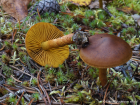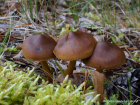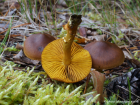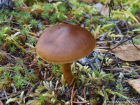Cap at first ochraceous-brown, becoming rust-coloured, finely felty convex, often slightly umbonate, finely fibrillose. Flesh chrome-yellow and fairly thin. Flesh chrome-yellow, fibrous, narrowly hollow, stuffed or full. Gills adnate or emarginate with a slightly decurrent tooth, at first yellow, then tawny and rust at maturity, fairly Crowded. Stem cylindrical, solid, and has a longitudinally fibrillose texture, with the surface covered in yellow or yellow-brown veil remnants. While there is no visible ring, a faint superior cortinal zone may be present. Spore print rusty-brown.
Microscopic Features: The spores are ovoid or slightly almond-shaped, ranging in size from 6.5 to 9 µm in length and 4.5 to 5.1 µm in width. They have a moderately to strongly verrucose surface, meaning they possess a roughened texture.
Cortinarius croceus on the First Nature Web site.
Cortinarius croceus on the MushroomExpert.Com Web site.
Many mushrooms are poisonous, and some can be lethally toxic. Distinguishing between edible and poisonous mushrooms can be very challenging. Therefore, we strongly advise against consuming wild mushrooms. This website does not contain any information about the edibility or toxicity of mushrooms.
Although efforts have been made to ensure accuracy on this website, the information may contain errors and omissions. Therefore, all content provided is for educational and informational purposes only and should not be relied upon or used as a basis for consuming any plants or mushrooms.
External links are provided for reference only. We do not endorse or take responsibility for the content, advice, or products found on these sites or in any advertisements shown on this website.



